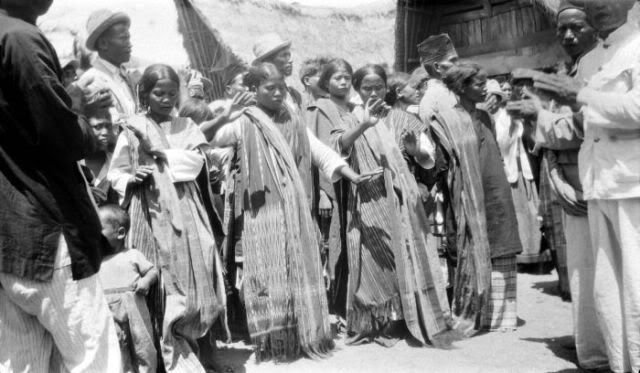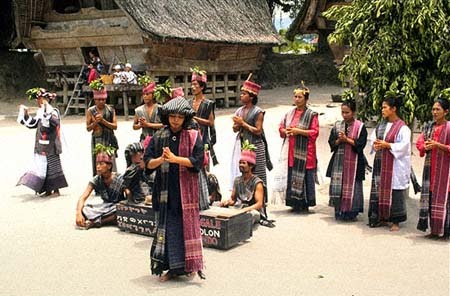history of batak tribe
Batak tribe is one of the largest tribes in Indonesia. This name is a collective theme to identify some ethnic groups who live and come from the West Coast and the East Coast in North Sumatra Province. The ethnic groups categorized as Batak are Toba, Karo, Pakpak, Simalungun, and Angkola. Batak is a clump of tribes that inhabit most of North Sumatra. But often people think Batak mention only to the Toba tribe when Batak is not represented by the Toba tribe. So there is no culture and language Batak but culture and language Toba, Karo, Simalungun and other tribes are cognate. Nowadays in general Batak people are Protestant, Catholic, Moslem. But there are also adherents of traditional beliefs namely: Malim tradition and also adheres animism belief, although now the number of adherents of these two teachings has diminished.
Batak people are speakers of Austronesian language but it is not known when the ancestors of Batak people first settled in Tapanuli and East Sumatra. Language and archaeological evidence indicates that Austronesian-speaking people from Taiwan have migrated to the Philippines and Indonesia about 2,500 years ago, ie in the stone age (Neolithic). [3] Because until now no Neolithic artifacts (Age Stone Age) found in the Batak region then it can be suspected that the ancestors of new Batak migrate to North Sumatra in the metal age.
In the 6th century, Indian Tamil traders established the Barus trading town, on the west coast of North Sumatra. They trade in Barus chalk that farmers in the interior work. Barley Chalk from high-quality Batak land to become one of the export commodities in addition to incense. In the 10th century, Barus was attacked by Srivijaya. This led to the expulsion of Tamil merchants from the coast of Sumatra [4]. In later times, Barus chalk trade began to be dominated by Minangkabau traders who established colonies on the western and eastern coast of North Sumatra. Their colonies extend from Barus, Sorkam, until Christmas.

Until now, theories are still debated about the origin of the Batak Nation. Starting from Formosa (Taiwan), Indochina, Mongolia, Mizoram and most controversially the Ten Lost Tribes of Israel.
The identity of Batak is popular in the history of modern Indonesia after the establishment and incorporation of youth from Angkola, Mandailing, Karo, Toba, Simalungun, Pakpak in the organization called Jong Batak 1926, without distinguishing Religion in one understanding: Batak language we are so rich in Poetry , A proverb and a proverb that contains a world of discrete wisdom, The language is the same from North to South, but is clearly divided in various dialects. We have our own culture, the script itself, the high-quality Building Art that throughout the period has proved that we have a mighty ancestor, The clan system that applies to all the population groups of our country shows the existence of a wise state structure, we are entitled to establish a unity of Batak characteristically, who can defend our interests and protect the ancient culture [6] R. Liddle says that before the twentieth century in northern Sumatra there were no ethnic groups as coherent social units. According to him until the 19th century, social interaction in the area was limited to relations between individuals, between kinship groups, or between villages. And there is almost no consciousness to be part of larger social and political units. [7] Another opinion suggests, that the emergence of awareness about a large family Batak newly occurred in the colonial era. [8] In his dissertation J. Pardede argued that the terms "Batak Land" and "Batak people" were created by foreigners. On the contrary, Siti Omas Manurung, a wife of the priest son of Toba Batak states that, before the arrival of the Dutch, all the people of both Karo and Simalungun recognized themselves as Batak, and it was the Dutch who had made separate groups. A myth that has various versions states that Pusuk Buhit, one of the peaks in the west of Lake Toba, is a place of "birth" of the Batak people. Besides these myths also states that the ancestors of the Batak people came from Samosir. The formation of Batak society composed of various clans, partly due to the migration of families from other regions in Sumatra. Important research on Karo tradition is done by J.H Neumann, based on oral literature and transcripts of two local texts, namely Kembaren and Pintaka Ginting. According to Pustaka Kembaren, the origin of the Kembaren clan of Pagaruyung in Minangkabau. The Tamil people are also thought to be the constituent elements of Karo society. This can be seen from the number of Karo clan names derived from Tamil Language. Tamils who traded on the west coast, fled into the interior of Sumatra due to the Minangkabau troop attack that came in the 14th century to dominate Barus.

The entry of Islam
During his visit in 1292, Marco Polo reported that the Batak people were "wild" people and were never influenced by outside religions. Although Ibn Battuta, visiting North Sumatra in 1345 and Islamizing Sultan Al-Malik Al-Dhahir, the Batak community never knew Islam before being spread by Minangkabau traders. Along with his trading business, many Minangkabau traders are married to Batak women. This has gradually increased Islam in the midst of Batak society. [10] At the time of the Padri War in the early nineteenth century, Minangkabau troops attacked the Batak lands and undertook a massive raid on the Mandailing and Angkola communities. [11] The kingdom of Aceh in the north, also plays a significant role in Islamizing Karo and Pakpak communities. While Simalungun much exposed to the influence of Islam from the Malays on the coast of East Sumatra.
In 1824, two British Baptist missionaries, Richard Burton and Nathaniel Ward walked from Sibolga to the interior of Batak. [12] After three days of walking, they reached the Silindung plateau and settled for two weeks in the interior. From this exploration, they made observations and direct observations on the life of the Batak community. In 1834, this activity was followed by Henry Lyman and Samuel Munson of the US Board of Commissioners for Foreign Missions. [13] In 1850, the Dutch Gospel Council commissioned Herman Neubronner van der Tuuk to publish grammar books and Dutch-language Batak dictionaries. It aims to facilitate the missions of Dutch and German Christians speaking with the Toba and Simalungun communities that were subjected to their Christianization. [14] The first German missionary arrived in the valley around Lake Toba in 1861, and a mission of Christianization was carried out in 1881. Ludwig Ingwer Nommensen. The New Testament was first translated into Toba Batak by Nommensen in 1869 and the translation of the Old Testament was completed by PH Johannsen in 1891. The text of the translation was printed in Latin letters in Medan in 1893. According to HO Voorma, this translation is not easy read, somewhat stiff, and sounds strange in Batak language. [15] Furthermore, the Catholic Mission in Batak Land counted since the first missionary pastor, Father Sybrandus van Rossum, OFM.Cap entered the heart of Batak Land, Balige on December 5, 1934. The people of Toba and parts of Karo absorbed Christianity quickly, and by the early twentieth century had made Christianity a cultural identity [16]. At this time is a period of revival of Dutch East Indies colonialism, where many Batak people have no longer fight against the colonial government. The guerrilla resistance carried out by the Toba Batak people ended in 1907, after their charismatic leader, Sisingamangaraja XII died.

Crypto Exchange In Australia?
This is a good article on the best crypto exchange Australia!?